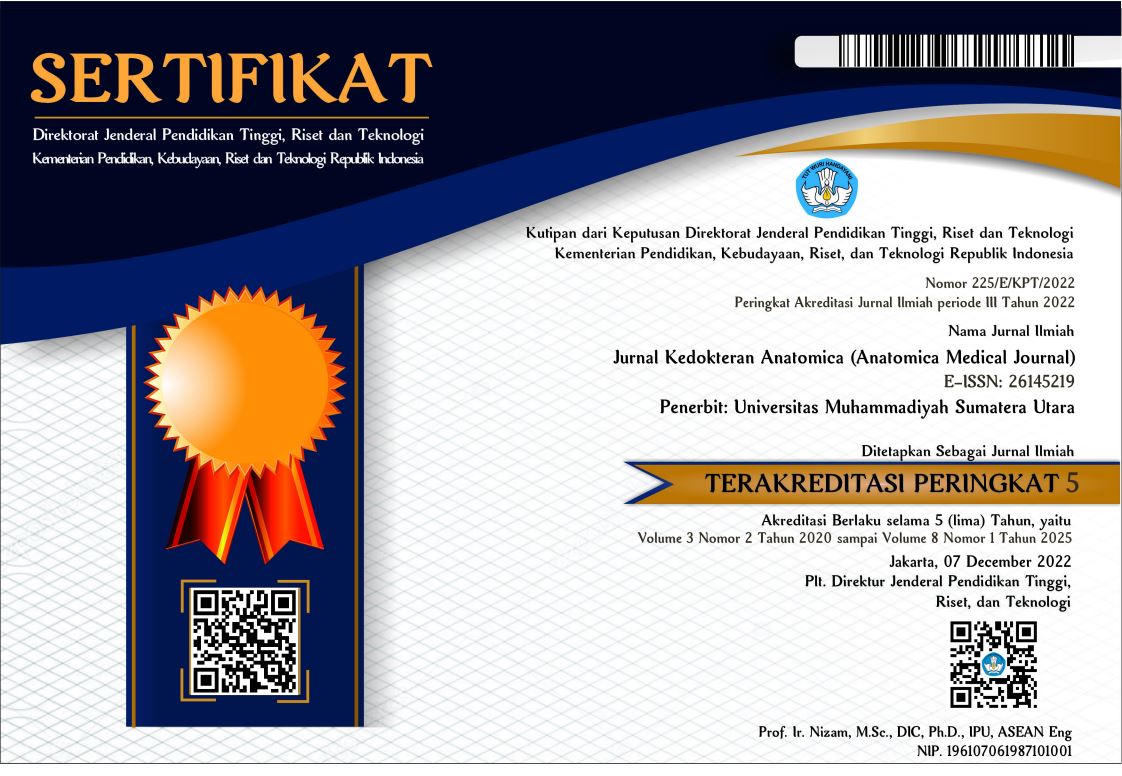Adamantinomatous Craniopharyngioma
Abstract
Kata Kunci: Adamantinomatous Craniopharyngioma, diagnosis, prognosis.
Full Text:
PDFReferences
Buslei R, Rushing E.J, Giangaspero F, Paulus W, Burger PC, Santagata S. Crangiopharyngioma. WHO classification of tumours of the central nervous system. Editor David N, Hiroko L, Ohgaki Otmar D, Wiestler Webster K, Cavenee. IARCPress, Lyon. France. 2016. p 324-8.
Rosai J. Rosai and Ackerman's Surgical Pathology. Crangiopharyngioma. Vol.2. 10th edition. Elsevier. Philadelphia.2011.
Bunin GR, Surawicz TS, Witman PA, Preston-Martin S, Davis F, Bruner JM (1998). The descriptive epidemiology of craniopharyngioma. J Neurosurg. 89(4):547-51.PMID:9761047.
Makino K, Nakamura H, Yano S, Kuratsu J; Kumamoto Brain Tumor Group (2010). Population-based epidemiological study of primary intracranial tumors in childhood. Childs Nerv Syst. 26(8): 1029-34. PMID:20349186.
Gjerris F, Agerlin N, Borgesen SE, Buhl L, Haase J, Klinken L, et al. (1998). Epidemiology and prognosis in children treated for intracranial tumours in Denmark 1960-1984. Childs Nerv Syst. 14(7):302-11. PMID:9726580.
Rosemberg S, Fujiwara D (2005). Epidemiology of pediatric tumors of the nervous system according to the WHO 2000 classification: a report of 1,195 cases from a single institution. Childs Nerv Syst. 21(11):940-4. PMID:16044344.
Nielsen EH, Feldt-Rasmussen U, Poulsgaard L, Kristensen LO, Astrup J, Jorgensen JO, et al. (2011). Incidence of craniopharyngioma in Denmark (n = 189) and estimated world incidence of craniopharyngioma in children and adults. J Neurooncol. 104(3):755-63. PMID:21336771
Snyder LA, Wolf AB, Oppenlander ME, Bina R, Wilson JR, Ashby L, et al. (2014). The impact of extent of resection on malignant transformation of pure oligodendrogliomas. J Neurosurg. 120(2):309-14. PMID:24313617.
Crotty TB, Scheithauer BW, Young WF Jr, Davis DH, Shaw EG, Miller GM, et al. (1995). Papillary craniopharyngioma: a clinicopathological study of 48 cases. J Neurosurg. 83(2):206-14.PMID:7616262
Koral K, Weprin B, Rollins NK (2006). Sphenoid sinus craniopharyngioma simulating mucocele. Acta Radiol. 47(5)494-6. PMID46796313
Kim MS, Kim YS, Lee HK, Lee GJ, Choi CY, Lee CH (2014). Primary intracranial ectopic craniopharyngioma in a patient with probable Gardner's syndrome. J Neurosurg. 120(2):337-41. PMID:24266539
Chentli F, Belhimer F, Kessaci F, Mansouri B (2012). Congenital craniopharyngioma: a case report and literature review. J Pediatr Endocrinol Metab. 25(11-12):1181-3. PMID:23329768
Adamson TE, Wiestler OD, Kleihues P, Yaargil MG (1990). Correlation of clinical and pathological features in surgically treated craniopharyngiomas. J Neurosurg. 73(1):12-7. PMID:2352012
Muller HL, Gebhardt U, Teske C, Faldum A, Zwiener I, Warmuth-Metz M, et al.; Study Committee of kraniopharyngeom 2000 (2011) . Post-operative hypothalamic lesions and obesity in childhood craniopharyngioma: results of the multinational prospective trial kraniopharyngeom 2000 after 3-year follow-up. Eur J Endocrinol. 165(1):17-24. PMID:21490122
Simoneau-Roy J, OGorman C, Pencharz P, Adeli K, Daneman D, Hamilton J (2010). Insulin sensitivity and secretion in children and adolescents with hypothalamic obesity following treatment for craniopharyngioma. Clin Endocrinol (Oxf). 72(3):364-70. PMID19486023
Rossi A, Cama A, Consales A, Gandolfo C, Garre ML, Milanaccio C, et al. (2006). Neuroimaging of pediatric craniopharyngiomas: a pictorial essay. J Pediatr Endocrinol Metab. 19 Suppl 1:299-319. PMID46700305
Hofmann BM, Kreutzer J, Saeger W, Buchfelder M, Bliimcke I, Fahlbusch R, et al. (2006). Nuclear beta-catenin accumulation as reliable marker for the differentiation between cystic craniopharyngiomas and rathke cleft cysts: a clinico-pathologic approach. Am J Surg Pathol. 30(12):1595-603.PMID:17122517
Schweizer L, Capper D, Holsken A, Fahlbusch R, Flitsch J, Buchfelder M, et al. (2015). BRAF V600E analysis for the differentiation of papillary craniopharyngiomas and Rathkes cleft cysts. Neuropathol Appl Neurobiol. 41(6)733-42PMID:25442675
Stache C, Holsken A, Fahlbusch R, Flitsch J, Schlaffer SM, BuchfelderM, et al. (2014) . Tight junction protein claudin-1 is differentially expressed in craniopharyngioma subtypes and indicates invasive tumor growth. Neuro Oncol. 16(2):256-64. PMID:24305709
Duo D, Gasverde S, Benech F, Zenga F, Giordana MT (2003). MIB-1 immunoreactivity in craniopharyngiomas: a clinico-pathological analysis. Clin Neuropathol. 22(5):229-34. PMID:14531547
Raghavan R, Dickey WT Jr, Margraf LR, White CL 3rd, Coimbra C, Hynan LS, et al. (2000). Proliferative activity in craniopharyngiomas: clinicopathological correlations in adults and children. Surg Neurol. 54(3):241-7, discussion 248. PMID:11118571
Biegel JA (1999). Cytogenetics and molecular genetics of childhood brain tumors. Neuro Oncol. 1(2):139-51. PMID:11550309
Acker T, Plate KH (2004). Hypoxia and hypoxia inducible factors (HIF) as important regulators of tumor physiology. Cancer Treat Res. 117:219-48. PMID:15015563
Buslei R, Nolde M, Hofmann B, Meissner S, Eyupoglu IY, Siebzehnriibl F, et al. (2005). Common mutations of beta-catenin in adamantinomatous craniopharyngiomas but not in other tumours originating from the sellar region. Acta Neuropathol. 109(6):589-97. PMID:15891929
Hama S, Arita K, Nishisaka T, Fukuhara T, Tominaga A, Sugiyama K, et al. (2002). Changes in the epithelium of Rathke cleft cyst associated with inflammation. J Neurosurg. 96(2):209-16.PMID:11838792
DOI: https://doi.org/10.30596/anatomica
DOI (PDF): https://doi.org/10.30596/amj.v2i1.2611.g2597
Refbacks
- There are currently no refbacks.
Jurnal Kedokteran Anatomica/ Anatomica Medical Journal (AMJ)
E-mail: amj_fk@umsu.ac.id || Editorial Contact: 081375150018
This work is licensed under aCreative Commons Attribution-ShareAlike 4.0 International License.


.png)
